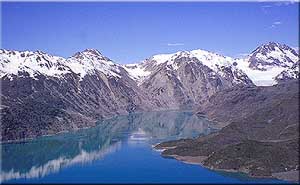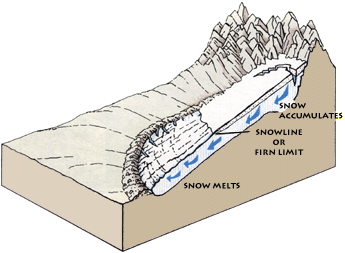The Birth of a Glacier
What does it take to grow a glacier?
Growing a glacier requires two essential ingredients: adequate snow fall and a cool climate. In warm climates, high mountain peaks may recieve heavy snowfall in the winter, only to have it melt away during the warm summer months. A cool climate means cool summers. In a cool climate, some winter snow may survive each year, providing a base for the next year's snow. Glaciers can grow only when the amount of snow that accumulates is greater than the amount that melts each year. Heavy winter snowfall and cool summer temperatures both favor the growth of glaciers.

|
| This image was taken in Summer near Glacier Bay National Park in Alaska. You can easily see that snow at lower elevations has mostly melted, while snow near the peaks persists. Only at high elevations can we find the right conditions for glacier growth. Click on image to see at full size. |
If conditions are right...
Over many years, perhaps a few centuries, layer upon layer of snow builds up. As the mass thickens the weight of the snow presses down, forcing the snow at the base of the glacier to recrystallize into dense glacial ice. Eventually, when the ice reaches a thickness of about 100 feet, the ice begins to squeeze outward and move under the pressure of its own weight. Once the ice starts to flow, it's no longer just a thick lump of ice-a glacier is born!As the glacier flows downhill, it descends to warmer zones where the snow melts from year to year. The boundary where snow melting equals snow accumulation is called the annual snowline. The snowline varies from year to year depending upon the amount of snowfall (precipitation) and temperature.

|
| A slice through a valley glacier. |
Glacier growth
As the glacier flows downhill, it descends to warmer zones where the snow melts from year to year. The boundary where loss from melting and evaporation equals accumulation from snowfall is called the annual snowline or firn limit-"firn" being the term for partially compacted snow carried over from previous seasons.The firn limit fluctuates from year to year in response to changes in precipitation and temperature. The firn limit can be as much as 1,000 ft lower in elevation on the shaded north sides of mountain peaks tan on their sunny south sides. For this reason, many present-day glaciers are found on the north-facing mountain slopes.
The section of the glacier through which the maximum amount of ice flows coincides with the firn limit, because as the glacier flows toward the firn limit, it is continually augmented by new net snowfall; and downvalley from the firn limit, more ice is lost by melting and evaporation-together called ablation-each year than is added by snowfall. As the glacier flows downvalley from the firn limit, more and more of the ice ablates, and the glacier grows thinner or narrower, or both. Ultimately a point is reached where the ice front can advance no farther because the ice melts there as rapidly as it is provided by inflow from up glacier. If the yearly rates of accumulation and ablation were constant, this point would be fixed. However, they vary, and for that reason alone the terminus of the glacier is not likely to be fixed in position. As the climate turns warmer or drier, a glacier will gradually waste away, rather than melting catastrophically.